ATW90: Myanmar
Back into sequence? This is part of the series of articles being written for the book, Around the World in 90 minutes
The Myanmar visit was in September 2017, and came directly after the my visit to Bhutan.
Please send any comments or corrections to atw90@leohoenig.com
Please follow me on facebook (Leo Hoenig), Twitter (@leohoenig) or Instagram (@hoenigleo)
I felt I really should not have gone to Myanmar. I was quite aware that as a country, it has always been frayed around the edges. Unfortunately, much of this was the fault of the British when negotiating independence. The British ruled the country as a single state, or even as a province of India, and ignored the many different small groups of people within the state. (This was not just a problem with British colonialism, look at the mess the Dutch left Indonesia in, partly because they created a single state). The Burmese majority and some of the other groups did sign an agreement, but others were left out, despite an original demand by Britain that this would not happen. The result is that ever since independence (70 years now), the country has been plagued by internal strife as the other groups, Karin, Shan, Rohingya demand their own rights and even independence. The North East of the country is reported as particularly lawless, but I was not going anywhere near there.
Trouble really started to flare in the week I was heading out of the UK. An insurgent group (or freedom fighters or terrorists, depending on your viewpoint), attacked police stations in Rakhine state. The main demand of the Rohingya people appears to be recognition. Although they have lived in the northern part of what is now the Rakhine state of Myanmar for generations, they do not hold Myanmar citizenship. The Myanmar government considers the whole group to be illegal Bengali immigrants. The Bangladesh government does not give them citizenship, as they live in Myanmar. When the British were in charge, they recognised the Rohingya as a tribe, but probably gave little thought to how they were spread across what would become the Burma/East Pakistan (now Bangladesh) border.
The border is porous at best, so no doubt there has been unregulated movement across it since the countries became independent, but the continuing repression in Myanmar means that it is not a great destination for illegal immigrants to head for. By the time I arrived in Myanmar, it appears that at least 250,000 people had been pushed across the border into refugee camps in Bangladesh, which simple cannot deal with the influx. The United Nations security council actually managed to condemn this, with both Russia and China accepting the motion.
Myanmar cannot control information, everyone here has mobile phones and internet connections, and outside news sources are available. The internal news however says that all outside sources are lies. I went to Mandalay and Bagan, two centres which rely on tourism to some extent, (Bagan only exists as a tourist destination). The various taxi drivers and guides I speak too, while managing to speak enough English to take me around, to negotiate fares, or to try and sell me trinkets I do not want or need, somehow do not understand a word when I ask about the situation, or how they are going to cope with the reduction in tourists that this is going to create.
From Bhutan, I had taken a flight back to Bangkok – like the outward one, it stopped in India – but a different airport to the one used in the other direction. My flight to Myanmar was the following morning, but from Bangkok’s older Don Muang Airport. I had booked a small hotel close to the airport, but my taxi driver had no idea where it was. Even after stopping close to the destination and getting directions from other drivers, he still had no idea. In the end, I had to stop at the wrong hotel, and take another taxi to complete the journey.
I landed in Mandalay. While Mandalay has always sounded like an interesting city, it does lack something. It is said that you are never far from a rat in any major city, but in most places they stay relatively well hidden. In Mandalay, you will see them if you take any short walk of an evening. It makes the plan of using street vendors for food seem somewhat unappealing.
I was picked up at Mandalay airport by the hotel’s transport. This was a good idea as the airport is a long way from the city centre, and no one likes to haggle with the local drivers before they have a true idea of costs. Indeed, I did not even hold currency until after I reached the hotel.
While we were heading to the city, I discovered we would pass close to the city’s impressive and modern football stadium. I could not get access inside, so had to content myself with a few outside pictures
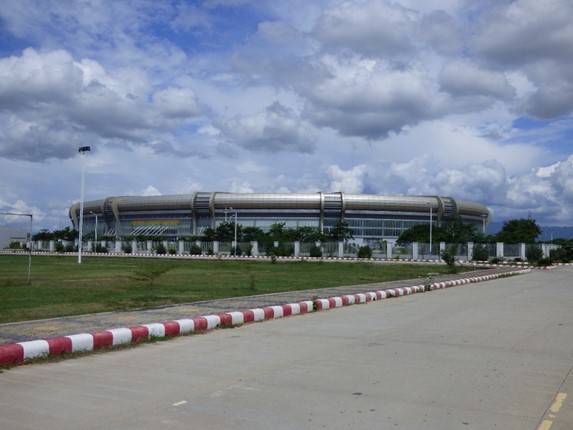
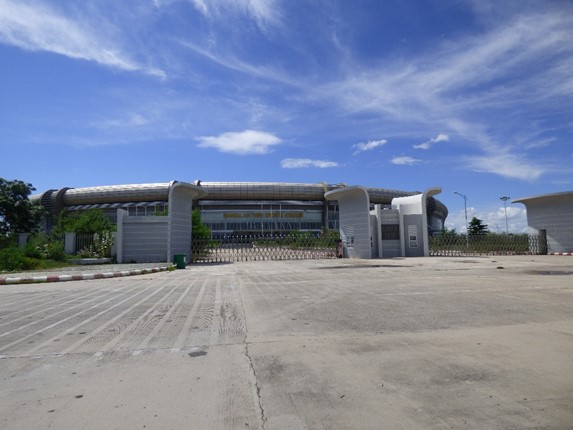
I now had two and a half days of sightseeing planned. First, I would walk look around Mandalay, then take a trip between Mandalay and Bagan, stopping at the most impressive temple on the route, and then I would spend a whole day travelling around Bagan, before taking a morning flight down to Yangon. It would be down in the commercial centre of the country where the football would take place.
I managed, of course to see many sights on my first three days, more than can be possibly be shown here, but here are small number of highlights. The first two are in Mandalay, the second pair at Mount Popa, which is en route between Mandalay and Bagan, (or if you are staying in Bagan, the place most taxi touts want to overcharge to take you to), and the rest are in Bagan itself.

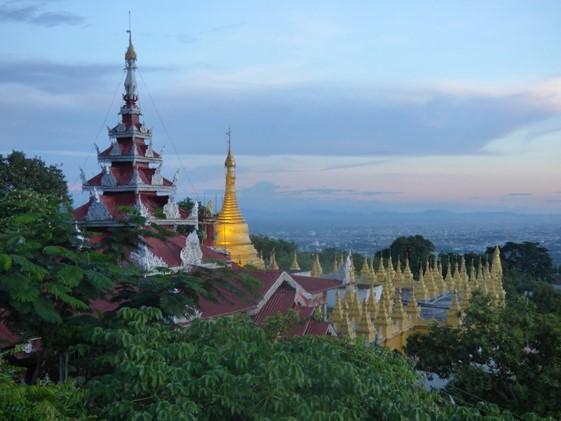
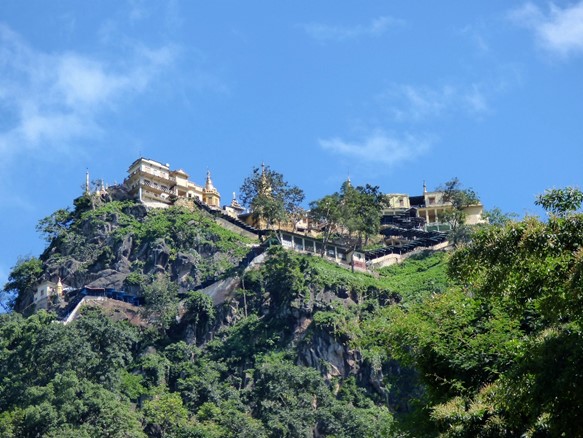
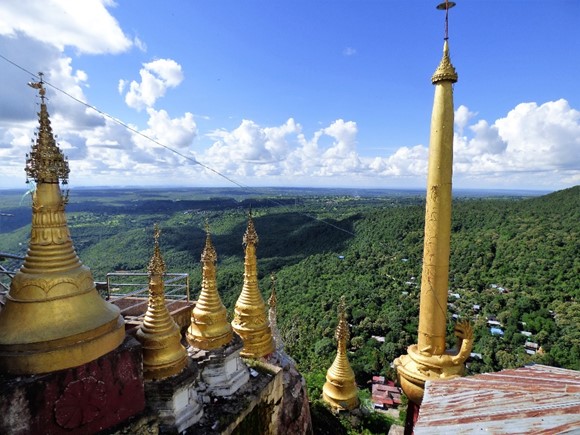
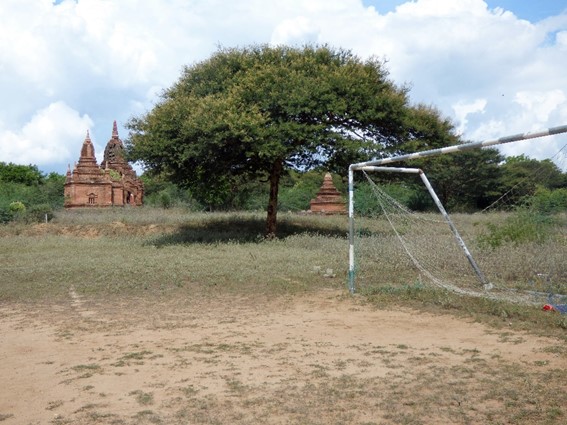
Being as this is a Football Blog, I could not resist this football pitch in Bagan, with a couple of small stupas behind. No sign to say when the next game would be.
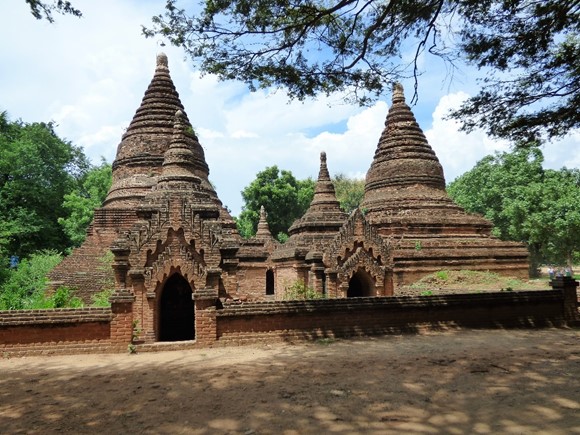
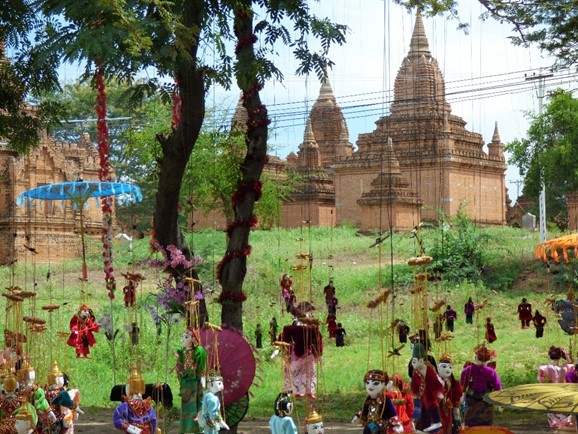

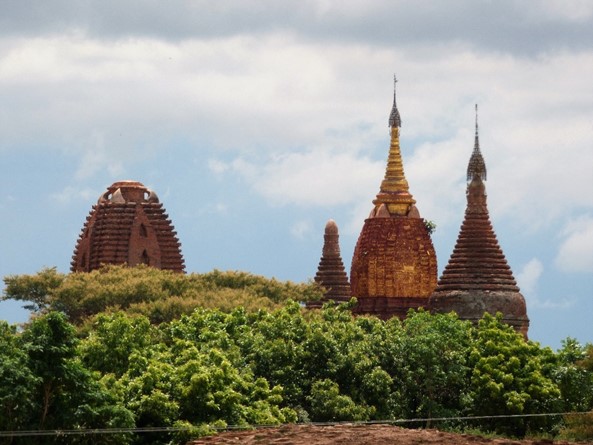
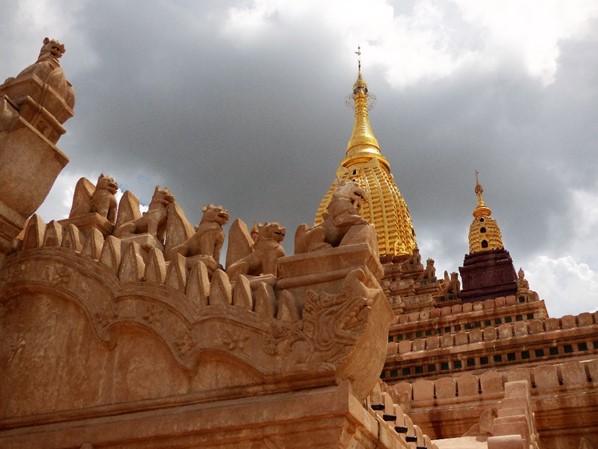
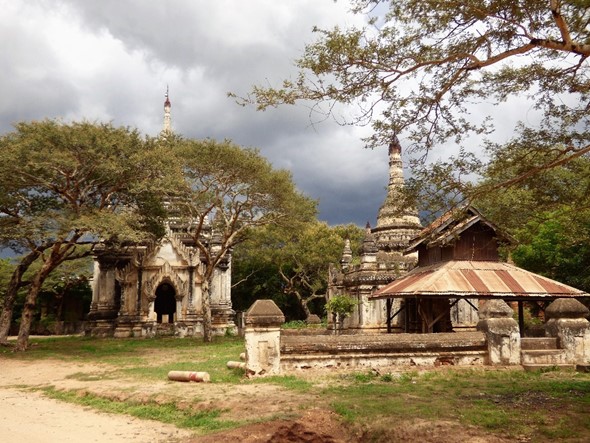
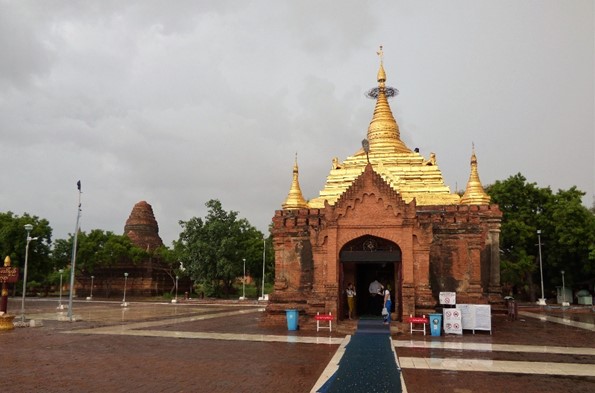
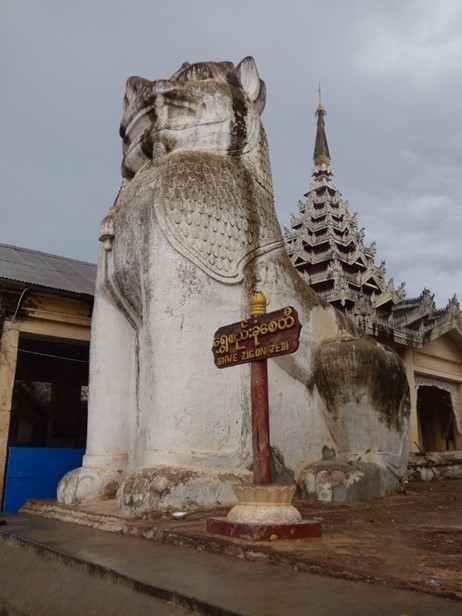

[
The Myanmar government makes a charge to visit the antiquities in Bagan, and please do not think for a moment that this goes mainly into maintenance, even if there are some signs that maintenance may be ongoing. The figure is 25,000 Kyat – which is in fact around £14. While this fee is well worth it, no one bothers to check if you have a ticket or not at most places. It was only at the last temple I visited, Shwesandaw that I was forced to hand over my money.
Still, it had to be paid as this is one tall temple, and you can climb up the sides (in relative safety). The views over the 360o panorama are magnificent, and naturally this is a favourite (and recommended) sunset hangout.
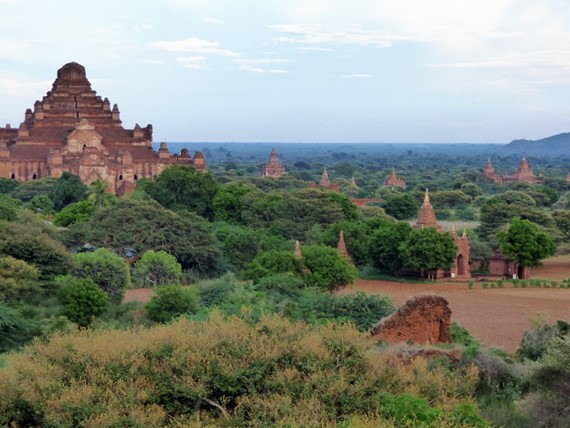
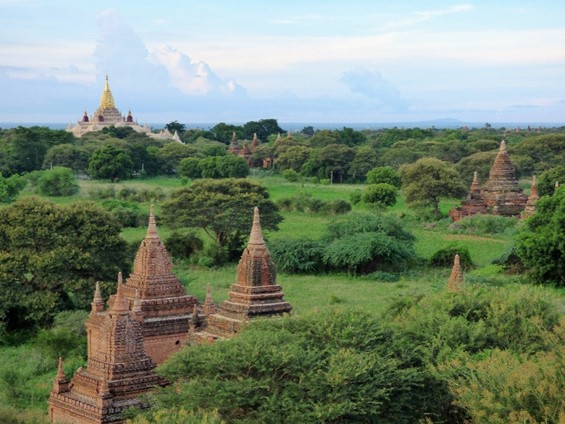


Of course, the next morning is Saturday, and I need to get to football. I am staying at a hotel near the airport, so it is a straightforward matter of getting their airport shuttle to the terminal – well they told me it was a bus!
In common with about 99% of the road traffic in Myanmar, this “bus” is right hand drive, and hence intended for a market where one drives on the left. In Myanmar, they drive on the right. I asked more than once about this and the answer I got was consistent. It is apparently because the cars are all made in Japan. The Japanese drive on the left (that much is true), and hence do not make cars for with the steering wheel on the other side, (such as China, USA and most of Europe).
This is repeated enough that I think the locals believe it. The true reason is that most vehicles in Myanmar were not intended for the local market, but were sent to neighbouring countries, (India mainly, but also Bangladesh and Thailand) where they do use the left hand side of the road.
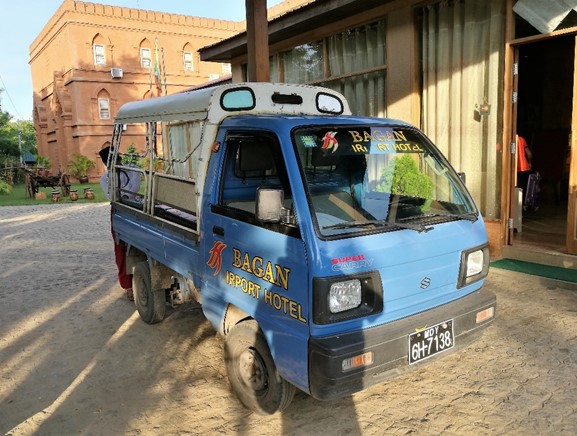
And then onto the plane, which starts off in the wrong direction and makes two other stops before getting to Yangon
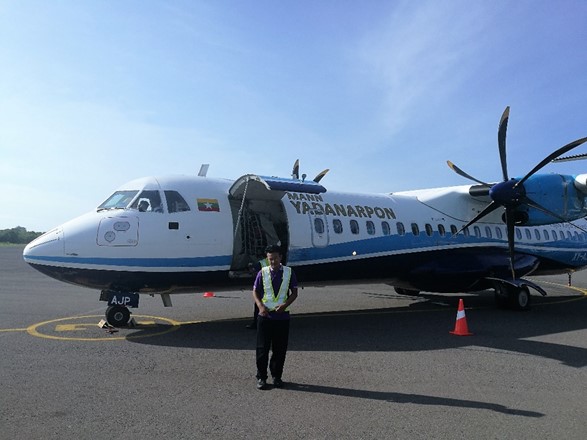
Some good aerial views, even if I did not spot the Shan United home ground
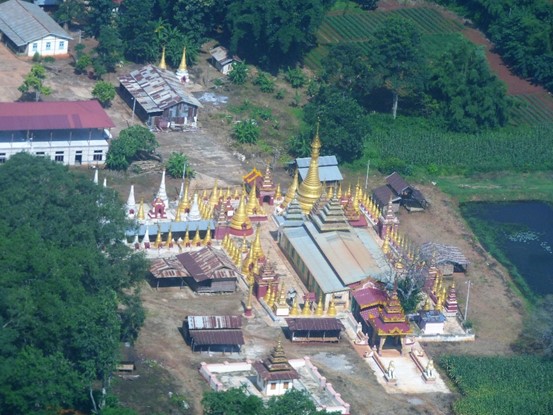
There were no delays in my flight, fortunately, which meant I had no difficulty in getting down to Yangon and into my hotel in good time.
After a short while in the hotel, I am on my way again, to see a Rakhine United “home” game. This is where football in Myanmar starts to get confusing. Rakhine is the state where the problems with the Rohingya was happening. When I started my trip, I assumed the game would be played within the state – I had even gone as far as looking to see if I could get there and the down to Yangon for a game on the Sunday. I do not think I had noticed that the Magwe do not have a home stadium, and therefore were due to play in Yangon as well that day, (Wikipedia lists a stadium for every club, but then notes that some are not in use). I had planned my timing with the thought I could travel to Hpa-an (about six hours on the bus) for Monday’s match and back on the Tuesday. This was in fact the main reason I had booked to leave the country on Wednesday, rather than the day before.
While the Myanmar National League web site confirmed the fixtures and kick off times well in advance, so as I was not just dealing with sites such as soccerway, it was only in the week before the match that they release the confirmed fixtures, with venues!
It turns out that Zwekapin’s matches were not in Hpa-an, but also in Yangon. Two other teams, Chin United and GFA, both of which hail from Chin also play their home matches in Yangon. Meanwhile, the number of matches for the weekend was reduced from six to five as the team from Nay Pyi Taw was thrown out of the league for not paying players’ wages.
All in all, therefore, six of the 12 clubs in the league play their home matches in Yangon, even though there is only one Yangon team in the league. It goes a step further than this, as all of the 12 (reduced to 11 by Nay Pyi Taw’s problems) actually train at the same place – the two artificial pitches next to the offices of the Myanmar Football Association offices, and across the road from the National stadium.
Even Yadanarbon, the team from Mandalay use the facilities in Yangon, which is rather sad considering that when I saw the outside of the stadium, the driver pointed out the academy pitches outside, and these present superior facilities to those in Yangon.
Another thing I discovered after I started planning was the existence of the ASEAN federation’s under-19 tournament, which would reach it’s final on the Sunday of my visit to Yangon. When this first came to my notice, I wondered if I could get from Yangon United’s ground after their Sunday match to the national stadium for the final. Google maps said yes, but I think the traffic would have made it close to impossible.
However, once I discovered that Rakhine were to use the Yangon United ground, it seemed that life would be simpler, as I could go there on Saturday, the National stadium for two U-19 games on Sunday and the Aung San stadium on the Monday.
It started hammering down with rain when the taxi was half way to the stadium, and on arrival the driver took my straight through the gates and then signalled to someone close by to come and hold an umbrella as I exited the door and walked to the stand. I’m not used to this. Normally, it rains, I get wet.
As a result, I do not even know if avoided paying to get in or not! I paid to get into the game on Monday, so I am guessing I missed paying (maybe almost 60p) here.
Anyway, despite being a modern artificial surface, it appeared the game would be in doubt. There was standing water right across the pitch, and despite people trying to sweep it clear, nothing could change until the rain stopped. But those of you that know South East Asia know that it rains hard, but rarely for long.
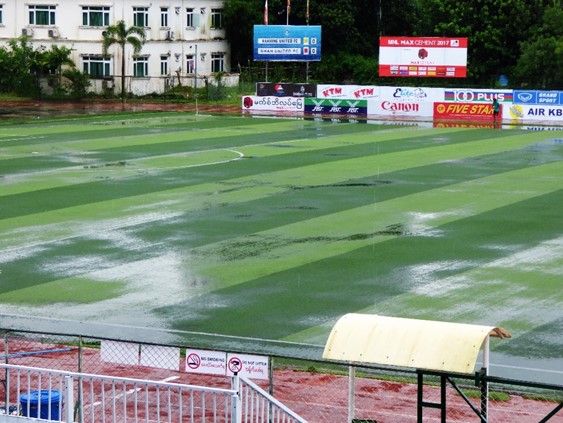
So, they announced a 30-minute delay to kick off. By that time the rain had stopped and the sweepers had returned the playing surface to something close to normal. There was no obvious water, but the surface was slippery, and this showed as the game went on. When a new rainstorm hit on the hour mark, the puddles soon appeared again, but the referee played through and all was back to normal by the end.
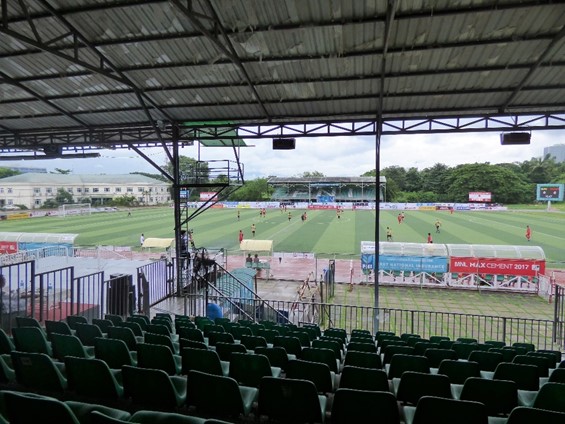
The Yangon United Sports Centre acts is the home ground for Yangon United, and also stages games for other teams as and when necessary. It has a track, but not full size. It has one long stand which goes all the way along the pitch, and another smaller one on the other side of the pitch. The only floodlights are attached to the top of the stands, so I do not think they are for match play (explaining the 3.30 kick off time), but as we did not start until 4.00, they were on at the end.

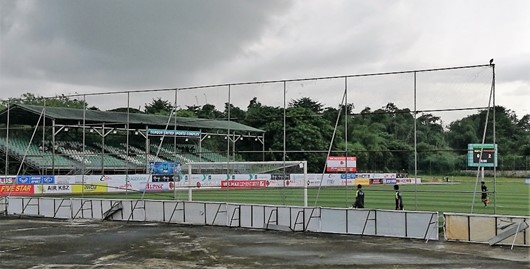
Shan United, are top of the league, and it was soon clear why. Playing in a 4-1-4-1 formation, they made good use of the wings, and utilised the power of their Nigerian forward Christopher Chizoba. It was two goals by Chizoba that gave them a half time lead. The first a powerful shot, after another player had sent a shot from distance onto the crossbar, and the second a tap in after good work from Han Kyungin. Han himself pounced on the loose ball following a corner on 65 minutes to complete the scoring.
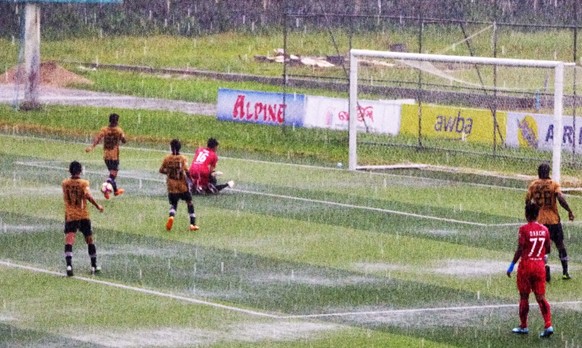
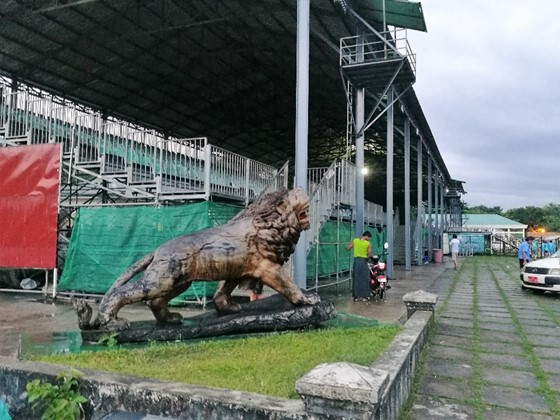
Rakhine’s best period of play came at the start of the second half, but they too frequently failed to find the man in the area with undirected crosses, or ended up with powder-puff shots. They kept trying to play, as fresh rain created puddles on the pitch in the second half, the best chance coming after a save by Thiha Sithu leaving Sunday Mathew with an open goal which he fluffed. The Nigerian players’ union matched this a minute later when Chizoba headed over.
The smallish crowd included people supporting both sides, including a fair group wearing Rakhine colours. It appears these are all Yangon residents who may have once lived in the state.
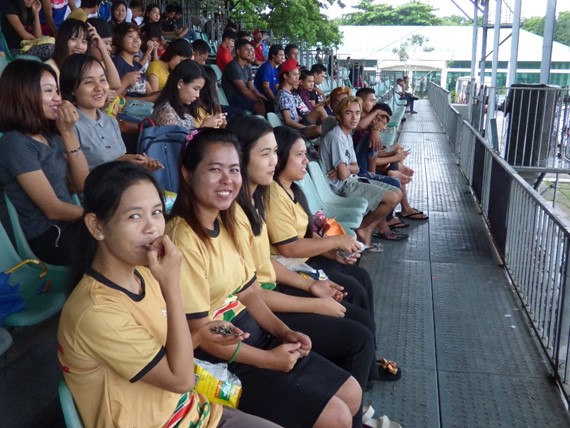
Chizoba, I noticed ended the season as joint leading goalscorer, I spoke to him briefly after the game, when he mentioned a desire to move higher, maybe to the Indian Super League, as he had already played in India. However, he has been stayed at Shan for the 2018 season
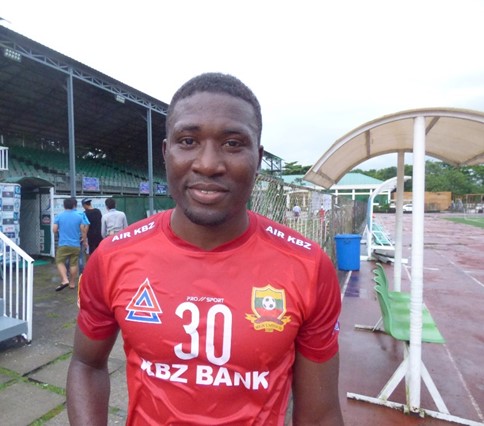
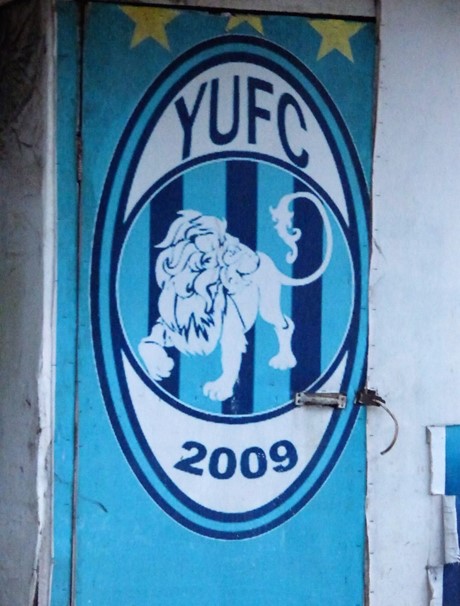

After the game, I had a quick drink (coffee!) in the café just outside the ground. All eyes are on the TV, showing the lunchtime game in England, just as night falls here. Leicester City are 2-0 down to Crystal Palace at half time. (final 3-0)
As a prelude to heading to the ASEAN Football Federation Under-19 finals on the Sunday, I first had to visit the Myanmar Association’s offices in the morning. The offices are just across the road from the main stadium and stand next to two artificial pitches.
Although it was not apparent, looking on, these pitches were sodden with water, and if you walked across them you get the splish-splosh that you might normally associate with walking on a carpet which has been flooded and not dried out.

The match when I wandered past was South Korea v Japan, or to be more accurate, a match between ex-pats working in Yangon from the two East Asian nations.
The fibres of the surface were all lying flat, which probably damages the drainage. One got the impression that there is a lack locally when it comes to translating the words, “regular maintenance”.
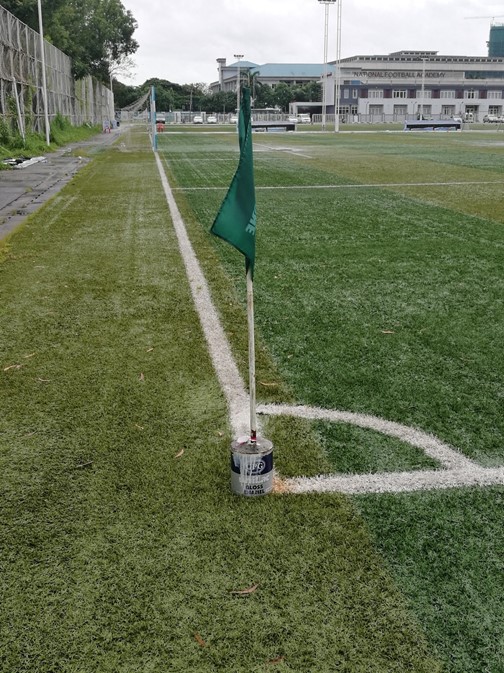
The sign on the building at the back reads “National Football Academy”, the corner flags are set in concrete within a can marked “Gloss Enamel” I’m sure the FA uses the same techniques at St. George’s Park.
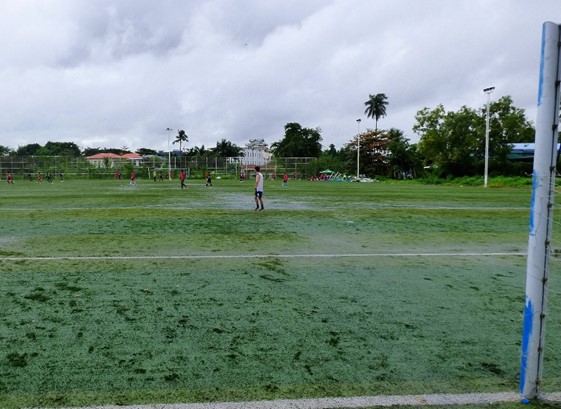
There is a lot of rivalry amongst the nations of South East Asia, and the ASEAN Football Federation organises at many levels. The tournament for U-19 players is held annually. Australia have been admitted to this region, even though they do not fit naturally into any Asian region, and may be better placed in the East, against South Korea, Japan and China. Although the Australians are the holders at this level, they have declined to enter this time around. New Zealand were originally invited to fill the gap, but then pulled out when the fixture schedule was given, (this was before the Rohingya business flared up). Hence, we had two groups one of six teams, the other of five.
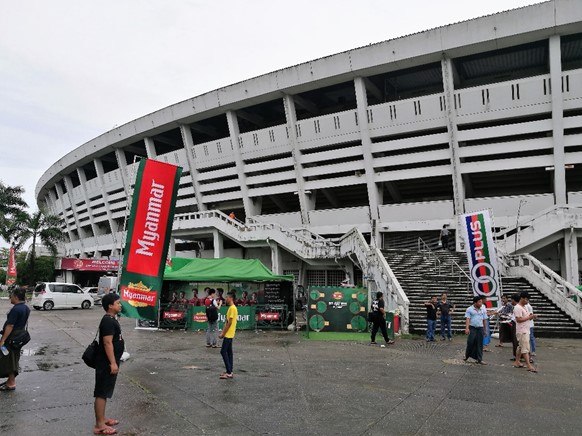
Group A, the six team group was dominated by Thailand and Malaysia, who both won four games before drawing with each other. The biggest surprise was when Timor-Leste (East Timor to you) beat Singapore in their final game to finish third. Malaysia were group winners on goal difference
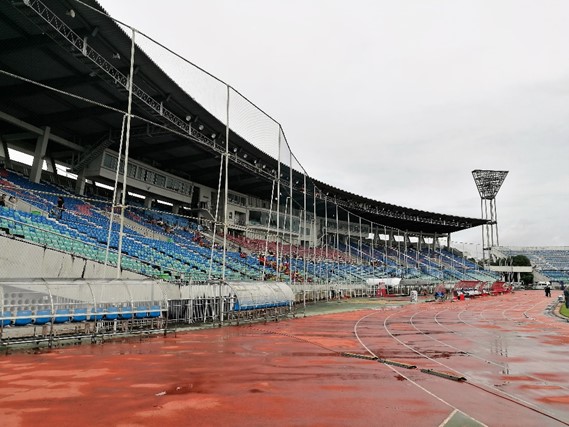
Group B was tighter, the Phillipines lost all four games, and Brunei only beat the Phillipines. Vietnam won their first three, including a 3-0 win over Indonesia, while Indonesia and Myanmar both had two wins before the final games. Indonesia had beaten Myanmar 2-1 thanks to a late injury time goal. Hence Vietnam had a +15 goal difference, plus they knew a draw made them group winners. However, Indonesia needed to make themselves safe in case Myanmar did win, which meant beating Brunei by 8-0. As it happened, the final score was Indonesia 8, Brunei 0.
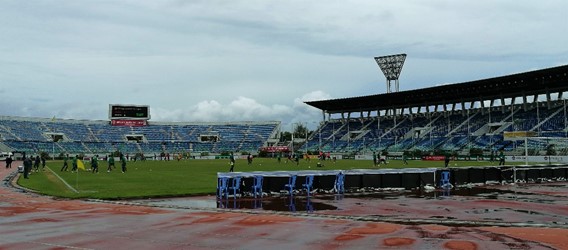
For the final game, this meant that Vietnam would win the group if they did not lose the game, but with a defeat, they would drop to third place, as the goal differences and goals scored would be identical with Myanmar (assuming a single goal defeat) and hence head to head for their match against Myanmar would be decisive. Vietnam were a goal to the good in the first minute, but Myanmar pulled it back and won with a goal four minutes from time.
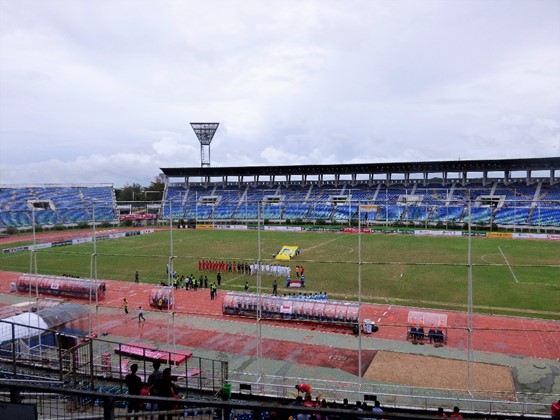
Both semi-finals finished scoreless. No extra time with only two days before the finals, and it was the group A teams, Malaysia and Thailand that went through. I was in a restaurant in Bagan for the semi-final, and it ground to a halt as the penalties came on. Even a group of French people stopped and cheered for the home team. Myanmar had an early penalty saved, but drew level when Malaysia’s fifth hit the post. But then another save stopped Myanmar on the first sudden death penalty, and Malaysia progressed by 5-4.
Although less central than the Aung San stadium, Thuwunna is the chosen national stadium for most international games. It was built in the mid-80s, Four curved stands, each two tiered surround an 8 lane running track. The two sides are roofed, while the ends are open. It is built mainly in concrete with large entrances to the seats between the tiers. The base row of seats are not more than 3 meters above pitch level, and while no one chooses to sit this low, quite a few of the home support do stand on the path that runs in front of these seats, forcing the sitting spectators further up.
For some reason, quite high mesh fences are erected on both sides of the ground, but not behind the goals. The mesh itself is too fine to interfere with the views, but the scaffolding poles that support it are a very annoying feature.
The pitch is grass, and the surface is clearly soft, with patches where the grass has worn thin, but despite the heavy rain and the high load on the surfaces, the surface actually appears better than the artificial surfaces at Yangon United and the training centre across the road.
Myanmar v Indonesia. Indonesia are on top from the start, forcing one good save and threatening the home defence well before a ball from the right is slipped through to an unmarked Mursalim who scores the first goal. As can happen, this results in a more positive play from Myanmar, and they should have levelled when Tun got into the area and found LW Aung in space, practically on the penalty spot, but he directed his shot straight at Savik in the Indonesian goal.
The pressure does not last, and on 27 minutes Sulaeman is released by a counter attack, picking up the ball in the centre circle and passing it into the net when the keeper advances for 2-0
Again, Myanmar push forward but without effect, the Indonesian keeper parries a couple of cross balls, but no one can finish them, while PS Naing fails to make contact with a cross from Tun.
This is the story of the game in a nutshell, Myanmar rushing to try and create chances which by and large come to nothing, their opponents being just that bit more clinical as they approach the goal. Indonesia are three goals to the good at the break, and extend this to six with a few minutes to go. Myanmar finally get a reward for their efforts in injury time, but there is still time for Indonesia to score again, and the final result is 7-1.
Close to the end, the announcer informs us that 16,000 are watching. I don’t know why he says this. There cannot be more than 1000 in the ground. The figure does not appear in the official records of the game, and I don’t think even the local press would report it.
By the time of the final, it is raining again and the pitch surrounds are looking very wet, but there is no standing water. Thailand get the first chance, a free kick from Noomchansakool is met on the far post by Kamingthong, but he puts the ball just over, then Rashid breaks forward for Malaysia, and hits the post when he should have scored.
The crowd has thinned out greatly, less than half of the figure from the first game, but there are two groups of noisy Thai supporters, each about 30 people and on opposite sides of the ground. For once, the rain is merely gentle, but less than a dozen people remain in the open seats, one of which has both an umbrella and a TV camera.
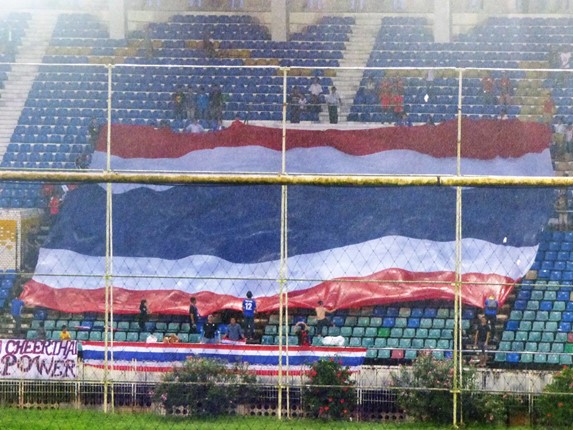
Thailand can just about muster enough fans to raise the giant flag before kick off.
The game is cagier than the first match, both sides will pass the ball right across the back line before choosing their position to push a forward ball. After the chances in the opening minutes, these are not finding the attacking players in space, as the defenders clearly have the upper hand. Malaysia have the most possession, but that is because they play more tippy-tappy at the back. Thailand are quicker to push the ball forward, and quicker to lose possession.
However, almost imperceptibly, Malaysia push their back line up and this moves the game into the other half of the field given Thailand some problems. Thailand have a player injured, but make two substitutions, so at least one is tactical. It is not changing the 4-1-4-1 formation used by both teams though. The new forward, Lertlum manages to get a shot close to the keeper which is blocked for a corner. Goalless at half time, I cannot see there being many added after the break, and a penalty shoot-out may well be the end result
The first goal comes from nowhere, a cross to one of the Thai substitutes, Panya, who is given a little space in the area, and a looping header which you could tell from the first moment was beating the Malay keeper. Within minutes it is two, a free kick from the right and Kamen meets it with a powerful header. A typical centre half coming up for the set piece.
Thailand continue to look the more dangerous, getting another three free kicks that all cause problems to Malaysia in the next fifteen minutes, but following the third of these, something happens off the ball, and Thai full back Kumkean is dismissed. Pulling a winger back, Thailand look to have moved to a 4-1-4-0 formation. Malaysia make the obvious change, bringing on Azeman, a forward in place of a midfielder, Thailand bring on a defender, which at least allows the winger back to his position, especially as Malaysia had created a chance in that space between the two substitutions. With this they revert to 4-1-3-1 and almost get a third when a header from Lertlum bounces off the crossbar
Thailand are happy to try time wasting tactics, such as having a player carried off on a stretcher, and then standing up fit enough to return. Malaysia have switched to 4-3-3 which is creating a few chances, with Razan hitting the ball over the bar in the 82nd minute and then beating the ground in frustration as he knows he should have got closer.
As we move on, it becomes clearer that Malaysia do not have the right moves to turn it around, as they keep pumping long balls into the area which are easily cleared. The call for four minutes of injury time is generous to Thailand, who immediately manage another injured player, and another minute lost.
Malaysia finally get their chance, two minutes into injury time when Khirudin is tripped in the box, but even this is to no avail as Manpati saves Azeman’s penalty. It was their last chance, the referee manages only to add 30 seconds to the four minutes, when two have been wasted (one for the injury, and one for the time between penalty award and it being taken). Still, for all their late gamesmanship, Thailand have bossed the second half and deserve their cup.
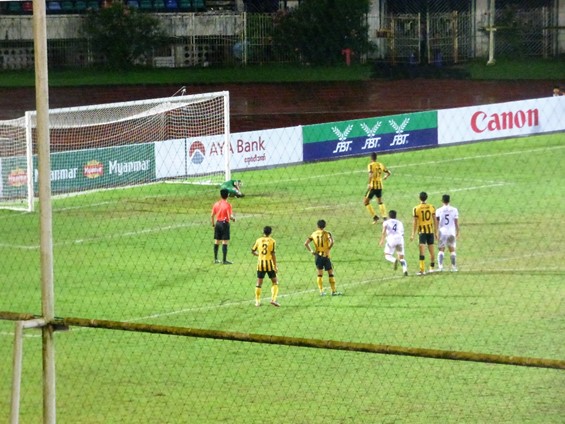
Viewed through the mesh – Malaysia’s late penalty is saved
As I had seen in Thailand, the first action of the Thai team after the whistle is to go over and cheer their fan group. About five minutes later the Malay team acknowledge (very briefly) a small group of their own fans, who were on my side of the ground, but had been quiet during the game.
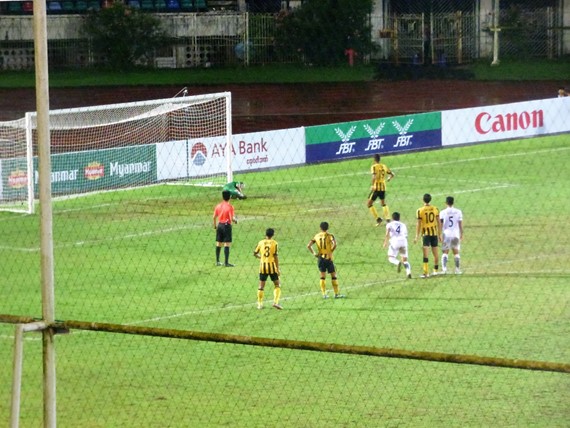
The rain, which had kept off during the second half of play suddenly becomes torrential again as we wait for the presentations.
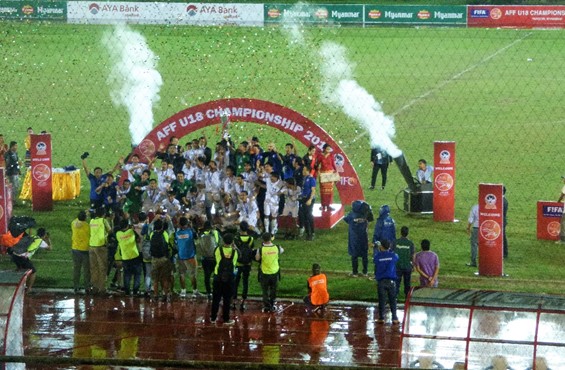
After this, I make my way back to the hotel, pleased with the days entertainment.
I take a little time to look around my locality, which is the old centre of Yangon on the Monday morning. The city is typical of this area of Asia, with its busy streets and crowded paving. There are a few sights to see, but the real joy here is not any specific item, but the kaleidoscope of noise and colour that makes up life in an Asian city.
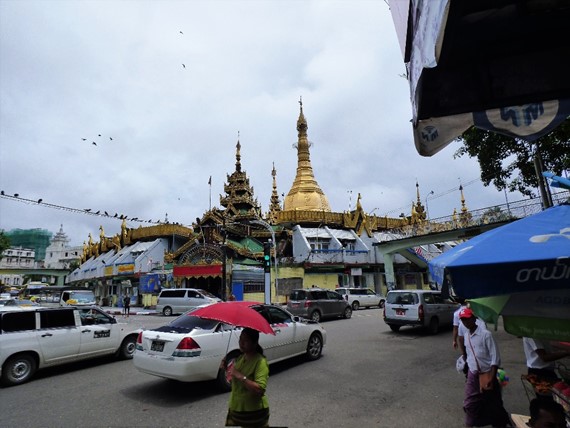
A Buddhist temple within a roundabout, and surrounded by shops
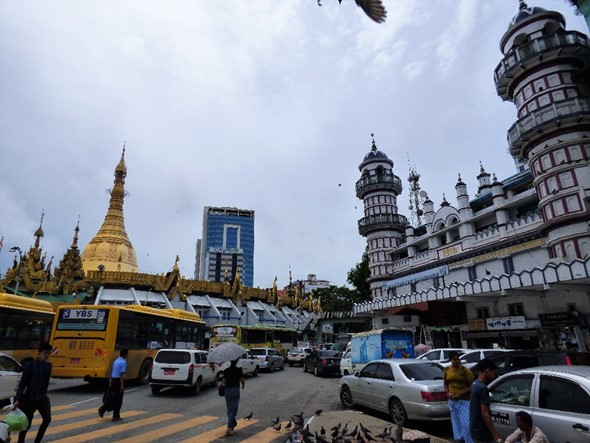
And to prove harmony is not impossible, the mosque across the road!
One unusual feature here, which sets the city apart from other cities in Myanmar, and Asia generally is the lack of motor scooters. In most cities, they are a popular form of travel, and it is a common site to see whole families riding on one scooter, but here they are banned.
The Aung San Satdium in Yangon is not far beyond where I was walking in the morning and I actually considered walking from the hotel, but the heavens opened at about 1.45. I started the walk 30 minutes later when there was a brief respite in the rain, and hailed a taxi five minutes later when the respite ended.
I ducked out of the taxi immediately outside the ticket stall, so I quickly paid my 1000 kyets (about 60p to you). It was still pissing down with rain as I walked into the ground, did not stop until well into the second half.
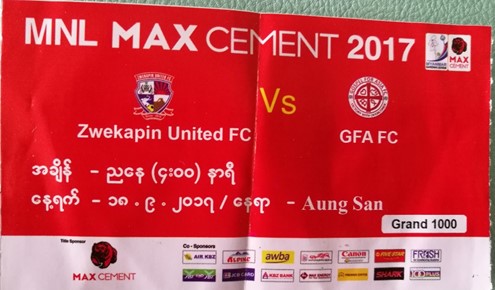
This is the old national stadium, it is not really bigger than the new one, even though the capacity quoted is. I asked one of the journalists covering the game (there were two to choose from) whether it might be better to kick off the Monday games later than 3.30.
He replied that the floodlights do not actually work, so it is not possible.
Open concrete stands on three sides, a newer covered stand where I came in to the West.
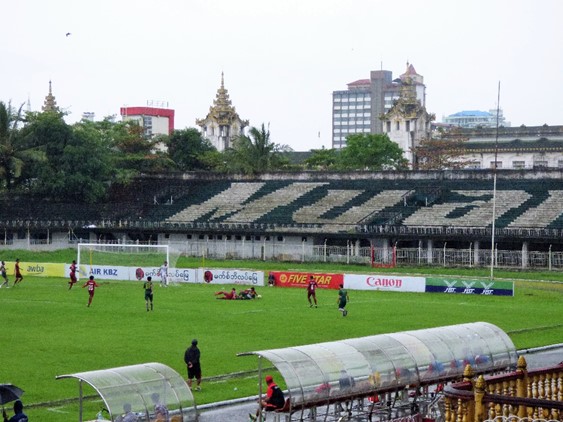
The “visiting team” is Gospel for Asia comes from Chin State, which seems plausible as the state has a majority Christian population according to wiki. GFA are bottom of the division, with Chin United one place higher. The state of Chin is one of the most impoverished in the country. Like its neighbour, Rakhine, it is in a continuous state of conflict, with the army trying to assert their authority by methods that to put it mildly, international groups such as Human Rights Watch find distasteful.
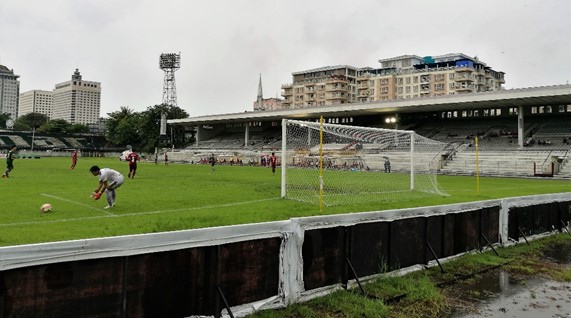
Zwekapin took the lead on 22 minutes. A free kick was parried by the visiting keeper. KS Lin got the loose ball on the right side of the field and crossed to the far post for YK Hywe to score.
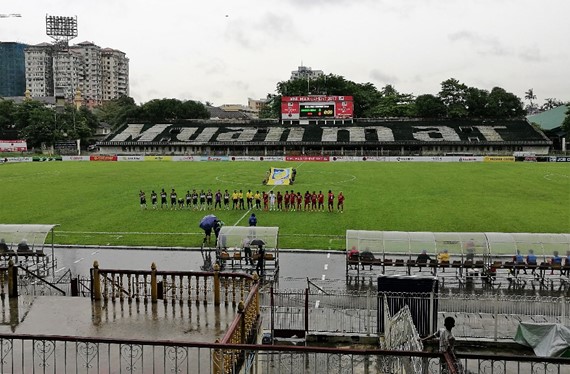
Slightly to my surprise, GFA equalised soon afterwards, a ball was played into SM Aung on the edge of the six-yard box, where either the keeper or the centre half should have taken it off him. Instead he was allowed to bring the ball down, turn and softly tap it in. Luis Carlos Martins restored the home sides lead, a diving header to a cross from SM Tun.
I thought that Zwekapin would be able to step up a gear after the break, but actually GFA had the better of the play. Still the home side should have made certain when Martins missed open chances in both the 80th and 81st minutes, (the first was easier). His manager decided he had seen enough, and replaced him with a defender, seeing out the game in a 5-2-3-0 formation.
No official crowd for this one, but my estimate was around 150. The impression I get is that bigger crowds can be seen outside Yangon, depending on the amount of success a team is having and the importance of the game – but this is not going to balance the costs the team incurs in travelling to the game. The national football association has only a little cash to distribute to the teams, so basically the 12 teams in the National League are all dependent on the amount of money their owners and sponsors can put in. Still, the division is a professional league, and even the second division has enough money that many teams have recruited foreign players, (which must therefore be full professional).

I had a brief chat with an agent who was meeting some of the players outside the ground, most of the foreigners in Myanmar football are from Africa, and they benefit from the centralised nature of the league, as they appear to group together between matches.
The chances of at least one of the Chin sides staying in the division has been enhanced with Nay Pyi Taw having been banned from the league with five games to play. All matches will be awarded 3-0 to their opponents. They still sit one point ahead of Chin, two ahead of GFA, but will not be allowed to stay up even if they were to stay in their current (non-relegation) position.
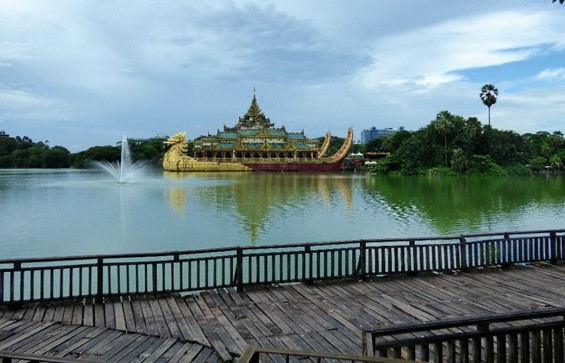
In the 2017 season, United of Thanlyin were removed from the second division after 10 games, (half way through the original season). Their results were expunged.
Also missing this season are Manaw Myay (last season’s second division champions), Zeyar Shwe Myay (mid-table top division last season). By the end of the season, GFA had done enough to be clear of the relegation zone, but Chin United finished bottom. Chin United did not continue running following their relegation, while the other relegated club, Nay Pyi Taw have also folded. For the second season in succession, the champions of the second division have dropped out of the league, rather than taking promotion.
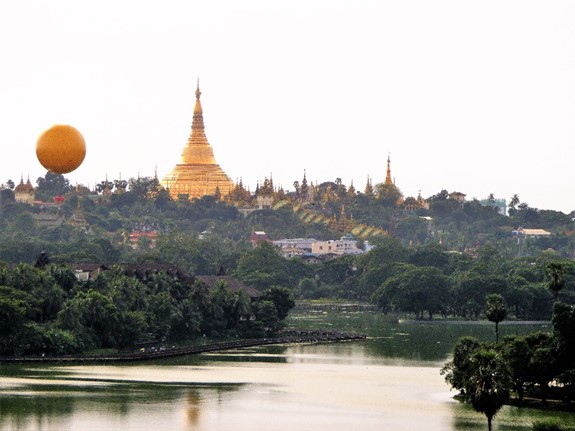
A view of the Shwedagon Pagoda. Not certain what the golden ball is for,
The demise of Chin United in particular is disappointing, as they were an interesting case. Their owner James Lian Sai started the side after running football competitions between players in orphanages in Yangon. He himself is running several orphanages. It appears that not all of the children are actually orphans, as with the poverty and conflicts in states such as Chin, many parents will send their children to the relative safety of the south. Still, the Chin are an ethnic minority within Myanmar, and as well as problems in their home area, they face discrimination and abuse in the larger city.
Despite that, Chin United have managed to develop players, and at least one has made it into the national team
The second division becomes more confusing with three of the teams changing names! It runs in 2018 as a seven-team league. In both 2017 and 2018, the second division is a Yangon only league, using the two main stadiums in the city, and the Padonmar Stadium, just north of the Shwedagon Pagoda (which is one of Yangon’s major attractions).
The top division continues much as before, with five of the clubs not being able to use grounds outside Yangon, so six of the 12 will play there again.
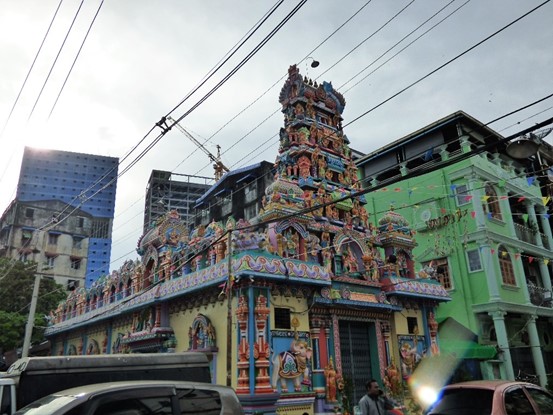
After the match I managed to find my way to Yangon’s only microbrewery. Finding it is typical of a taxi drive in the city. First you show him the address in writing and on a map on your phone. He then quotes you a price, (in this case, one that I thought was very low). He then heads off in completely the wrong direction to a place which he thinks you are going to. You then point out the real address, and the phone number attached, (which you had also suggested in the first place). Eventually he makes his way in the right direction, hitting the traffic at every corner. The brewery is slightly hidden in an industrial area, and the driver has to ask three times close by to find it. This is not helped of course by the fact he does not follow his directions as given.
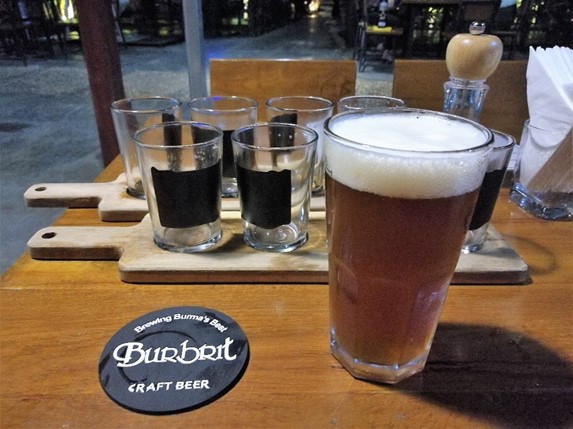
Let is be known that I like a good beer!
In this case, I paid more than the original quote, in line with the cost I thought I should pay. Fortunately, the return journey was easier, the pub called the taxi for me, and his price was reasonable. He even knew where my hotel was.
The week before my visit, Kyrgyzstan called off their home Asian Cup match with Myanmar due to the threat of protests by their Muslim population against the visitor’s treatment of the Rohingya. The situation is worse, not better with this match now re-arranged for March. Meanwhile, the subject has faded from the world’s TV screens, but like many of the other conflicts in Myanmar still goes on. Even the pope managed to fail to mention it while in the country. In Myanmar, the official version is still believed in almost all quarters and any alternative view is down to foreign dislike of Myanmar and its leaders. Something of a mistaken assumption as Aung Sun Suu Kyi is still someone seen as a heroic leader by most of the world, and until this crisis, she was almost the “Asian Nelson Mandela”. Carefully burying the rest of the administration’s human rights abuses in the sand.
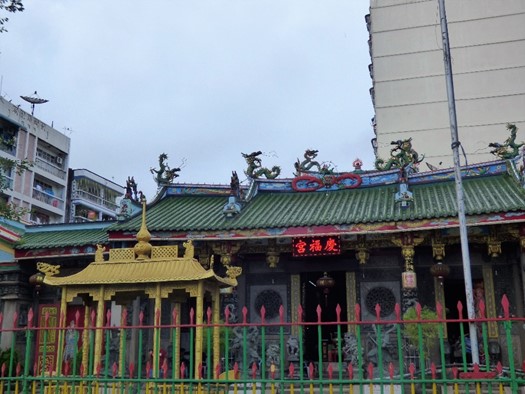
In such a country, the problems of the Football organisations appear to be small potatoes. Still, I cannot help but think that devolving the development of the game away from Yangon would not only be good for the game, but could act for the good of the country. Half the teams play home games in front of miniscule crowds in one city, while the other half travel from this city to play in front of much better crowds elsewhere. If the government could help provide facilities for football in Rakhine (Rohingya), Chin (Chin) and Hpa-an (Karen), this might be a move in the right direction for bringing communities together, rather than the conflicts that plague the country.
Still, I leave with the thought that the country’s chosen name is so close to the that of the Muppet song, Manah Manah, Myanmar? And the lyrics are so appropriate to the way home and foreign governments seem to view the problems
Myanmar? (ba dee bedebe), Myanmar, (ba debe dee)
Maynmar! (ba dee bedebe badebe badebe dee dee de-de de-de-de)